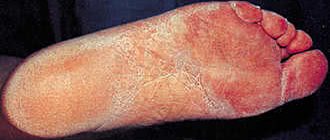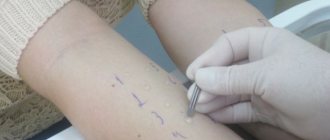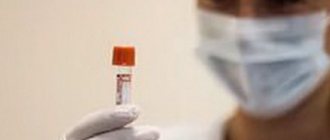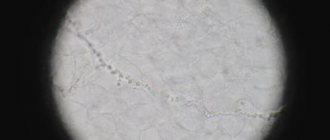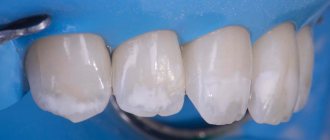Urticaria is a group of diseases (mainly of an allergic nature), the characteristic symptom of which is a rash on the skin in the form of red blisters.
In Russia, urticaria is very common - from 10 to 20% of the population have experienced its manifestations at least once in their lives. Moreover, in the majority it occurs in an acute form (70-75%), in the rest it takes a chronic course. WHO (World Health Organization) predicts that the 21st century will be the century of allergies. Every year the number of patients with one form of allergy or another increases by 5%.
Symptoms and mechanisms of development of urticaria
Manifestations of urticaria
The appearance of the main symptoms of urticaria - blisters and redness - is associated with the mechanism of development of the disease. This is an increase in vascular permeability and acute swelling in the tissues that surround the vessels.
The mast cell plays a leading role in the development of urticaria. These are special immune cells, the granules of which contain special biologically active substances (mediators). The most studied of them is histamine. It is because of its action that the symptoms of urticaria arise - rashes, redness, swelling, itching.
A blistering rash appears suddenly on any part of the body, disappears quickly and without a trace within 24 hours, and then appears elsewhere. When you press on the center of the redness, a white spot is visible.
The itching begins at the same time as the rash. This is how histamine acts on nerve endings.
Depending on the factor that activated the release of histamine from mast cell granules, different types of urticaria are distinguished.
In children with urticaria, there may be a deterioration in their general condition: increased body temperature, disruption of the digestive system (diarrhea).
Treatment of allergic urticaria in adults
Allergic urticaria is a dermatological reaction to exposure to a factor with a protein structure.
The disease is characterized by increased immune reactivity and is accompanied by specific rashes similar to nettle marks. In 40% of adult patients, the condition is combined with symptoms of angioedema1. It is characterized by isolated swelling of a part of the body with the formation of dense edema affecting the subcutaneous fat and dermis of the skin. Urticaria affects approximately 15-25% of the population, and in 30% the disease is chronic4.
The disease requires complex treatment aimed at eliminating the allergen from everyday life and blocking the mechanisms that provoke the formation of the rash. Ignoring the problem is dangerous, as the condition progressively worsens, up to anaphylactic shock. In addition, this type of allergy significantly worsens the quality of life and can cause psychological problems and neuroses.
Types of urticaria
| Acute urticaria |
| Cholinergic urticaria |
| Mechanical urticaria |
There are several classifications of urticaria.
1. By time:
- acute – lasts up to 6 weeks;
- chronic – more than 6 weeks.
2. By nature:
- allergic (immune) - realized through the development of an immune reaction, often combined with other allergic diseases (bronchial asthma, rhinitis, conjunctivitis, dermatitis, etc.);
- non-allergic - through the direct release of histamine.
3. Due to:
— allergic urticaria
may cause:
- Food;
- taking medications;
- insect allergens (insect allergy);
- pollen allergens.
— non-allergic
form of the disease occurs due to a direct effect on the mast cell:
- physical factors - such as cold, heat, ultraviolet radiation, radiation, vibration, compression;
- chemical (provoking factors are solvents, acids, alkalis and other chemicals);
- certain medicines, such as aspirin;
- infectious agents - viruses (adenoviruses, Epstein-Bar virus, enteroviruses), streptococci, helminths, Helicobacter pylori;
- for systemic and other chronic diseases (rheumatoid arthritis, systemic lupus erythematosus);
- with a sharp increase in the level of histamine and other active substances in the blood due to the large consumption of foods high in them: eggplants, canned food, nuts, bananas, chocolate and others.
Hereditary, psychogenic, and idiopathic urticaria (this is the name for a disease whose cause has not been established) is also possible.
The wide variety of factors and similar developmental mechanisms of individual species make it difficult to find the cause. Most often, this requires the help of a specialist.
Urgent Care
Algorithm of action in the event of a sudden allergic reaction with characteristic rashes:
- Immediately stop contact with the allergen, if possible. If we are talking about food or medicine, then the use of sorbents is recommended. It is not advisable to perform gastric lavage on your own due to the risk of Quincke's edema. When bitten by insects, it is recommended to limit the spread of poison and remove the sting.
- Taking second generation antihistamines. One of the recommended drugs, which begins to act after 20 minutes, is Cetrin. The active substance Cetirizine is characterized by high efficiency and reduced side effects, including drowsiness2.
- If signs of breathing problems, changes in heart rate, drop in blood pressure, or signs of Quincke's edema appear, you should immediately call an ambulance4.
Treatment of urticaria in adults is carried out immediately after the onset of symptoms. Delay can cause life-threatening complications, especially with continuous exposure to the allergen.
When and which doctor to contact
Usually a doctor is consulted:
- if the rash spreads over a large area;
- when symptoms increase;
- when signs of general intoxication occur;
- if the urticaria does not go away on its own after eliminating the factor that caused it;
- if the disease becomes chronic or often recurs,
It is advisable not to delay your visit to the doctor and come when the first manifestations of the disease occur. Then it will be easier to establish the cause, and treatment will take less time. In addition, the doctor will recommend what to do to prevent hives.
A therapist or pediatrician, a dermatologist can provide assistance with urticaria, and an allergist is involved in targeted diagnosis and treatment.
Treatment of the disease
If the allergen is known, then the main recommendation is to avoid, if possible, contact with the substance that provokes hives. That is why accurate diagnosis is important - it is necessary to understand which group of chemical compounds can lead to the development of urticaria. It often happens that the same substance is found in different foods or in different pharmaceuticals. And an allergy to pets can affect only one breed or spread to almost all pets, from cats to hamsters.
Therapy is needed if the disease has become a recurrent form - this happens if it is impossible to stop contact with the provocateur. In a situation where test results show the presence of an infectious focus, it is necessary to determine the infectious disease. It is likely that the urticaria will go away after healing.
If a patient is diagnosed with an allergy to dust, food or plants, then lifestyle changes are required: frequent wet cleaning, following a proper diet and avoiding walking during the flowering period of plants. Concomitant treatment is designed to alleviate symptoms when they reappear.
Diagnostic procedures for urticaria
Diagnosis of acute urticaria is usually quite simple. An examination and questioning of the patient about his medical history is sufficient. Finding out the reason is not so easy, and for this purpose additional research is carried out:
1. Laboratory tests:
- general blood and urine analysis;
- blood biochemistry (liver tests - ALT, AST, bilirubin, rheumatic tests, blood glucose);
- stool examination (coprogram);
- bacterial cultures from the nasal and pharyngeal mucosa.
2. Instrumental research:
- chest x-ray;
- Ultrasound of the abdominal organs;
- endoscopic examinations of the upper and lower gastrointestinal tract (gastroscopy, colonoscopy).
3. Allergy tests:
- intradermal tests with allergens;
- cold and heat tests;
- physical stress tests, line drawing, tourniquet application.
4. Immunological methods.
5. Consultations of related specialists:
- gastroenterologist;
- endocrinologist;
- rheumatologist;
- gynecologist and others as necessary.
First of all, it is important for a specialist to establish what nature the urticaria is – allergic or non-allergic. In the allergic form, one can clearly trace the connection between the symptoms and the introduction of the allergen. It is confirmed by skin, allergy and immunological tests.
Urticaria is a heterogeneous disease or syndrome, the main manifestation of which is skin rashes in the form of blisters, accompanied by itching. Depending on the duration of persistence of the main clinical symptoms, acute and chronic forms of the disease are distinguished. In addition, urticaria is also classified according to pathogenesis and severity. Modern principles of urticaria treatment are presented in the form of a set of therapeutic measures, including the elimination of causally significant allergens or triggers, treatment of concomitant pathologies, the prescription of second-generation antihistamines and, if therapy is ineffective, the use of alternative medications.
Principles of treatment of acute and chronic urticarias
Urticaria is a heterogenous disease or syndrome, the main manifestation of which is a wheal and itch. Depending on the duration of the persistence of the main clinical symptom the acute and chronic forms of the disease is diagnosed. It is also used the classification of urticaria pathogenesis and disease severity Modern treatment includes a range of elimination activities, treatment of comorbidity, administration of the II generation antihistamines for treatment failure and the use of alternativemedication.
Urticaria is one of the most complex and controversial problems of modern practical medicine. Numerous epidemiological studies indicate an extremely high prevalence of this pathology in the general population, which reaches 15-25% [1-3]. This leads to a high referral rate of patients with urticaria to specialists in various fields: dermatologists, allergists, pediatricians, general practitioners, etc. Urticaria negatively affects the quality of life of patients, affecting almost all areas of human activity. Against the background of severe skin itching that accompanies the disease, patients experience a decrease in attention, sleep deteriorates, and their ability to work is significantly impaired. Cosmetic defects resulting from rashes and swelling worsen the emotional state of patients, limit their social activity, which creates difficulties in interpersonal relationships, communication with friends, classmates, and work colleagues. Despite numerous methods recommended by modern consensus documents in the diagnostic algorithm for urticaria, the cause of the disease, especially its chronic forms, can rarely be identified. It is known that 80-95% of patients with chronic urticaria are diagnosed with an idiopathic form, which creates objective difficulties in the treatment of these patients and worsens the prognosis of the disease as a whole [1].
Thus, urticaria is an important medical and social problem, for the effective solution of which specialists of various profiles, possessing basic information about modern possibilities for diagnosing and treating the disease, must coordinately, taking into account the whole variety of factors influencing the development and course of urticaria, carry out comprehensive treatment of this complex pathology.
According to the Russian national consensus document, urticaria is defined as an etiologically heterogeneous disease or syndrome, the main manifestation of which is a blister (lat. Urtica). The blister, in turn, being the primary element of the skin rash, is a local swelling of the papillary dermis, resulting from vasodilation and increased vascular permeability. Clinically, the urticarial element is manifested by hyperemia, limited swelling of the skin and is accompanied by severe itching. A characteristic feature of a blister is its persistence on the skin for no more than 24 hours, followed by resolution without the appearance of any secondary changes on the skin, however, it should be borne in mind that subsequently urticarial elements may reappear in other areas of the skin [2-6].
If urticarial elements on the patient’s skin are observed from several hours to 6 weeks, then urticaria is classified as acute, but if the skin process lasts more than 6 weeks, then urticaria is chronic. Acute urticaria (AU) occurs in 25% of the population and is more often observed in children and adolescents [2, 7-9]. The main causes of acute urticaria are the ingestion of foods, medications, stings from hymenoptera insects, and viral infections. Chronic urticaria (CU) affects up to 5% of the population and is more common in patients aged 30 to 45 years [1-3, 8, 9]. As already indicated, in most patients the cause of chronic urticaria remains unknown. However, it should be noted that in chronic urticaria, concomitant chronic diseases play a significant role in the induction of the pathological process. Among them, the pathology of the gastrointestinal tract deserves special attention: gastroduodenitis, peptic ulcer of the stomach and duodenum, biliary dyskinesia, chronic cholecystitis. No less important in the induction and maintenance of relapses of urticaria is the presence in patients of concomitant parasitic (giabliosis, toxocariasis, opisthorchiasis), bacterial (H. Pylori), viral or fungal infections. In addition, urticaria can accompany some endocrine diseases, such as autoimmune thyroiditis, and also be a syndrome of systemic connective tissue diseases, tumor processes, etc. [10-13]. Thus, the etiological and trigger factors for the formation of acute and chronic urticaria are extremely diverse and must certainly be taken into account when planning complex treatment of patients with urticaria.
Both acute and chronic urticaria, depending on the severity of the main clinical symptoms of the disease (the number of urticarial rashes and the intensity of skin itching), are divided into mild, moderate and severe forms (Table 1).
Table 1.
Assessing the severity of urticaria
| Points | Blisters | Itching |
| 0 | None | Absent |
| 1 | <20 blisters in 24 hours | Easy |
| 2 | 20-50 | Moderate |
| 3 | >50 blisters or a few giant urticaria | Expressed |
| Sum of points | Urticaria severity | |
| 0-2 3-4 5-6 | Lightweight Moderate Heavy | |
In addition, there is a pathogenetic classification of urticaria (Table 2), which reflects not only the diversity of mechanisms for the formation of various forms of the disease, but also indicates a significant number of causally significant factors “guilty” of its induction, which must be taken into account by the doctor when planning individual treatment programs for a patient with urticaria [2, 3].
Table 2.
Pathogenetic classification of urticaria
| |
pressure
| |
| |
| |
| |
| Idiopathic urticaria | |
Despite the fact that traditionally in the minds of many specialists there is a belief that urticaria is a classic allergic disease, nevertheless, data from a significant number of researchers, as well as our own many years of experience, indicate that in the vast majority of cases (90-95%) urticaria does not have an allergic development path, where the role of the process inducer would belong to a specific allergen [1, 2, 9, 13]. In a significant number of cases, we observe physical forms of urticaria (dermographic, cold, etc.), cholinergic urticaria (especially in adolescence), as well as the idiopathic form of chronic urticaria [14, 15]. Consequently, differentiated recommendations for prescribing a hypoallergenic diet to patients with urticaria, limiting the intake of medications, physical activity, contact with cold air, etc., which are included in the modern standard of non-drug treatment of urticaria, become justified. At the same time, all patients suffering from urticaria must follow a hypoallergenic diet with the exclusion of causally significant allergens from the diet, if they were identified during the examination, as well as histamine-liberating products, which include food additives (azo dyes - E102-124) and preservatives benzoates (E210-219), natural salicylates, products containing tartrazine (Table 3), alcohol. A strict hypoallergenic diet must be prescribed for a period of at least 3 weeks. If it is followed, in the case of an allergic reaction to food, improvement occurs within 24-48 hours, and if the reaction is pseudo-allergic, then after 2-4 weeks; spontaneous remission occurs in 50% of patients within 3-6 months [2].
Table 3.
Food products containing salicylates and tartrazine
| Salicylates | Tartrazine |
| -In the form of additives: soft drinks, canned food, cheese, margarine, mustard. -In the form of natural ingredients: tomatoes, cucumbers, potatoes, peppers, apples, grapes, apricots, peaches, plums, citrus fruits, prunes, raspberries, black currants, gooseberries, blackberries, strawberries | -Gastronomic products: sausages, sausage, butter, cheese, ham, pasta. -Confectionery products: cakes, pastries, cookies, pudding, ice cream, caramel, chewing gum. -Soft drinks. Yellow tablets and capsules |
In addition, it is advisable for a patient with urticaria to limit the intake of medications that can cause degranulation of mast cells by non-immune mechanisms (narcotic analgesics, some groups of antibiotics, X-ray contrast agents, B vitamins, local anesthetics, angiotensin-converting enzyme inhibitors), medications that slow down the process of histamine destruction (clavulanic acid, verapamil, aminophylline, etc.), as well as those that disrupt the metabolism of arachidonic acid (non-steroidal anti-inflammatory drugs) [1, 2, 16].
In the case of physical urticaria, the patient is advised to avoid the physical factor that can cause the patient’s condition to worsen. For example, with cold urticaria - do not contact with cold air and do not eat chilled foods; with cholinergic urticaria, avoid intense exercise and stressful situations; with pressure urticaria, do not wear tight clothes, belts and do not engage in heavy physical labor, etc. d. [1, 2, 14].
Thus, etiological treatment is aimed at eliminating possible (probable and identified) causes of urticaria, at the same time it is necessary to prescribe drug treatment.
Antagonists of HI histamine receptors are currently the only pathogenetically substantiated group of drugs recommended for the treatment of patients with urticaria [1-2, 16]. The main mediator, histamine, released from mast cell granules, acts on histamine receptors in the skin and causes itching. When interacting with HI receptors on postcapillary venules, histamine induces the release of nitric oxide, which stimulates the production of cyclic guanosine monophosphate (cGMP), which leads to vasodilation, increased vascular permeability and edema. Conducted studies on the use of antihistamines of the latest generation for the treatment of various forms of urticaria have a high level of evidence; therefore, modern domestic and foreign guidelines recommend this particular group of drugs as first-line therapy in the treatment of any form of urticaria [17-23]. At the same time, modern medical approaches to the treatment of acute and chronic urticaria have some differences. Thus, acute urticaria is often an emergency condition and requires immediate therapeutic measures. The amount of pharmacotherapy is determined by the severity of acute urticaria. For mild urticaria, it is usually sufficient to prescribe second generation antihistamines per os in a therapeutic dosage. The course of treatment is up to 1 month. In case of moderate or severe disease, parenteral administration of drugs is necessary. In this case, to provide emergency care, it is possible to use only first-generation antihistamines, since only they have an injection form (for example: clemastine 0.1% or chloropyramine 2.5% in age-specific dosages IM or IV up to 2 times a day day for 5-7 days). The therapeutic effect with this method of administering the medication will occur faster. In addition, if the disease is accompanied by laryngeal edema, the use of oral drugs in this situation is extremely difficult. In addition, in patients with severe forms of urticaria, especially with a tendency to generalize the process, in addition to 1st generation antihistamines, it is necessary to administer systemic glucocorticosteroids (prednisolone IM or IV at a dose of 1-2 mg/kg body weight), and also, if indicated, carry out detoxification therapy for 3-4 days (hemodesis 2.5 ml/kg intravenously, the maximum single dose for infants is 50 ml, for children 2-5 years old - 70 ml, for children 6-9 years old - 100-150 ml, for children 10-15 years old - 200 ml, adults 200-400 ml intravenously). After 2-3 days, with positive clinical dynamics of the disease, GCS and infusion therapy can be discontinued, and first-generation antihistamines can be replaced with second-generation drugs, which are recommended to be taken subsequently for a month [24].
Drug therapy for chronic urticaria should also begin with the prescription of H1-histamine receptor blockers, but of the second generation. The classification of second generation H1-histamine receptor blockers (original drugs) is presented in Table 4 [25]. It is known that second generation antihistamines have a number of advantages, which include a higher affinity for histamine H1 receptors, rapid onset and a longer duration of action - up to 24 hours. Second generation antihistamines are highly selective for histamine receptors and do not affect other receptors - cholinergic and muscarinic, and they also do not have the effect of tachyphylaxis. In addition, second generation antihistamines have virtually no effect on the central nervous system, and, as a result, when they are used, there is a lack of sedation and minimal impact on the cognitive sphere of patients, which is extremely important especially in childhood [2, 16, 17] .
Table 4.
second generation antihistamines
| International name | Trade names | Dosages for adults | Dosages for children | ||
| Loratadine | Claritin | 10 mg per day | From 2 years of age, with a body weight of less than 30 kg - 5 mg (1/2 tablet) or 5 ml (1 teaspoon) per day with a body weight of 30 kg or more - 10 mg (1 tablet) or 10 ml ( 2 teaspoons) per day | ||
| Ebastine | Kestin | 10, 20 mg per day | From 12 to 15 years: 10 mg (1/2 tablet) per day | ||
| Active metabolites of second generation antihistamines | |||||
| Desloratadine | Erius | 5 mg per day | From 1 to 5 years - 1.25 mg/day (2.5 ml), From 6 to 11 years - 2.5 mg/day (5 ml), Over 12 years old - 5 mg/day (10 ml) | ||
| Cetirizine | Zyrtec | 10 mg per day | From 6 to 12 months - 2.5 mg (5 drops) per day. From 1 year to 2 years - 2.5 mg (5 drops) 2 times a day. From 2 to 6 years - 2.5 mg (5 drops) 2 times a day or 5 mg (10 drops) 1 time a day. | ||
| Levocetirizine | Xizal | 5 mg per day | From 2 to 6 years - 1.25 mg (5 drops) 2 times a day | ||
| Fexofenadine | Telfast | 120, 180 mg per day | From 6 to 11 years - 30 mg (1 tablet) 2 times a day | ||
When choosing a specific second-generation antihistamine in pediatric practice, you must be guided primarily by the age restrictions specified in the instructions for use of the drug. In addition, it should be taken into account that second-generation drugs currently include so-called “active metabolites”, the use of which can provide a predictable therapeutic effect, as well as more adequate tolerability of the drug, which is especially important if patients with chronic urticaria have concomitant pathology [25, 26].
If treatment of chronic urticaria with second-generation antihistamines for 2-4 weeks is ineffective, the patient is prescribed drugs of an alternative line of therapy (Fig. 1).
Figure 1. Principles of treatment for chronic urticaria
One alternative treatment option is a combination of H1 and H2 histamine receptor blockers. It is known that about 15% of histamine receptors in the skin are of the H2 type, which justifies the possibility of combination therapy for patients with chronic chronic disease and the inclusion of H2-histamine receptor blockers in the complex of therapeutic measures. Recommended drugs for use are ranitidine (150 mg 2 times a day), cimetidine (400 mg 2 times a day) and famotidine (20 mg 2 times a day) [27, 28]. However, it should be noted that the use of medications in this group has age restrictions, and they are not prescribed to children under the age of 12-14 years.
If the patient is diagnosed with an autoimmune form of chronic urticaria, or urticaria is severe and is not controlled by taking antihistamines, then the patient is additionally prescribed systemic glucocorticosteroids per os. It should be noted that there is no standard regimen for prescribing GCS, however, most authors recommend using prednisolone at a dose of 1 mg/kg body weight until the symptoms of the disease completely disappear (usually 5-7 days of use are sufficient), followed by discontinuation of the drug according to an intermittent regimen [2].
Another alternative treatment method for chronic urticaria is the combined administration of second-generation antihistamines with antileukotriene drugs. Modern domestic consent documents indicate that the use of such a combination is possible only if the other treatment regimens listed above have not led to a positive result [2]. The effectiveness of antileukotriene drugs in patients with urticaria is associated with their selective blockade of leukotriene receptors LTC4, LTD4 and LTE4, which are involved in the pathogenesis of urticaria formation, released from an activated mast cell. Unlike histamine, which is a preformed mediator, leukotrienes are formed during the metabolism of arachidonic acid under the action of the enzyme 5-lipoxygenase and are secondary mediators synthesized de novo. The discussed mediators can maintain and enhance the urticarial reaction in patients with chronic urticaria due to vasodilation and increased vascular permeability. Currently, two groups of antileukotriene drugs are known: zafirlukast (Acolate) and montelukast (Singulair). However, according to studies based on the principles of evidence-based medicine, it was found that the combination of montelukast and second generation antihistamines has the most pronounced positive effect in the treatment of CC, while an assessment of the effectiveness of zafirlukast in similar patients with CC showed the comparability of the results obtained with placebo. In addition, a number of studies have shown that the most significant therapeutic effect when prescribing such a combination of drugs is observed in patients suffering from chronic urticaria in combination with bronchial asthma and/or intolerance to non-steroidal anti-inflammatory drugs , which can be considered as the therapy of choice in this category of patients [29 , thirty].
Thus, the modern approach to the treatment of urticaria involves a whole range of therapeutic measures, including the elimination of etiological and trigger factors that provoke the disease, treatment of concomitant pathologies, as well as pharmacotherapy using highly effective and safe antihistamines, and, if necessary, alternative medications.
O.V. Skorokhodkina, A.R. Klyucharova
Kazan State Medical University
Skorokhodkina Olesya Valerievna
Doctor of Medical Sciences, Professor of the Department of Clinical Immunology and Allergology
Literature:
1. Goryachkina L.A., Kashkina K.P. Clinical allergology and immunology. Guide for practicing physicians. - M.: Miklos, 2009. - P. 222-271.
2. Urticaria and angioedema: recommendations for medical practitioners. Russian national conciliation document. - M.: Farmus Print Media, 2007. - 127 p.
3. Urticaria. Clinical recommendations. Russian Society of Dermatovenerologists. - 2007. - 36 p.
4. Khaitov R.M., Ilyina N.I. Allergology and immunology. National leadership. - M.: GEOTAR-Media, 2009. - P. 75-98, 461-472.
5. Khaitov R.M., Ilyina N.I. Clinical recommendations. Allergology. - M.: GEOTAR-Media, 2008. - P. 104-115.
6. Kaplan A. Clinical practice: chronic urticaria and angioedema // N. Engl. J. Med. - 2002. - Vol. 346, No. 3. - R. 175.
7. Zuberbier T., Maurer M. Urticaria: current opinions about etiology, diagnosis and therapy // Acta Derm. Venerol. - 2007. - Vol. 87. - P. 196-205.
8. Zuberbier T., Bindslev-Jensen C., Canonica W. et. al. EAACI/GA2LEN/EDF guideline: definition, classification and diagnosis of urticaria // Allergy. - 2006. - No. 61. - P. 316-320.
9. Zuberbier T., Asero R., Bindslev-Jensen C. et. al. EAACI/GA2LEN/EDF/WAO guideline: definition, classification and diagnosis of urticaria // Allergy. - 2009. - No. 64. - P. 1417-1426.
10. Philpott H., Kette F., Hissaria P. et. al. Chronic urticaria: the autoimmune paradigm // The international medical journal. - 2008. - Vol. 38. - P. 852-857.
11. Konstantinou GN, Asero R., Maurer M. et. al. EAACI/GA2LEN Task force consensus report: the autologus serum skin test in urticaria // Allergy. - 2009. - No. 64. - P. 1256-1268.
12. Najib U., Sheikh J. The spectrum of chronic urticaria // Allergy and Astma Proceedings. - 2009. - Vol. 30, No. 1. - P. 1-10.
13. Roger W. Cronic urticaria: mechanisms and treatment // Allergy and Asthma. - 2001. - Vol. 22, No. 2. - P. 97-100.
14. Black AK, Lawlor F., Greaves MW Consensus meeting on the definition of physical urticarias and urticarial vasculitis // Clinical and Experimental Dermatology. - 1996. - Vol. 21. - P. 424-426.
15. Wong RC, Fairley JA, Ellis CN Dermographism: a review // J. Am. Acad. Dermatol. - 1984. - No. 11. - P. 643.
16. Zuberbier T., Asero R., Bindslev-Jensen C. et. al. EAACI/GA2LEN/EDF/WAO guideline: management of urticaria // Allergy. - 2009. - No. 64. - P. 1427-1443.
17. Ring G., Brockow K., Ollert M. et. al. Antihistamines in urticaria // Clinical and experimental allergy. - 1999. - Vol. 29. - P. 31-37.
18. Nettis E., Colanardi MC, Paradiso MT et. al. Desloratadin in combination with montelucast in the treatment of chronic urticaria: a randomized, double-blind, placebo-controlled study // Clin. Exp. Allergy. - 2004. - Vol. 34. - P. 1401-1407.
19. Nettis E., Colanardi MC, Barra L. et. al. Desloratadin in the treatment of chronic urticaria: a randomized, double-blind, placebo-controlled study // British journal of Dermatology. - 2006. - Vol. 154. - P. 533-538.
20. Kapp A., Pichler WJ Levocetirizine is an effective treatment in patients suffering from chronic idiopathic urticaria: a randomized, double-blind, placebo-controlled, parallel, multicenter study // Int. J. Dermatol. - 2006. - Vol. 45. - P. 469-474.
21. Kapp A., Wedi B. Chronic urticaria: clinical aspects and focus on a new antihistamine, levocetirizine // J. Drugs Dermatol. - 2004. - Vol. 3. - P. 632-639.
22. Asero R. Chronic anremitting urticaria: is the use of antihistamine sabove the licensed dose effective? A preliminary study of cetirizine at licensed and above – licensed doses // British society for immunology, Clinical and Experimental Dermatology. - 2006. - Vol. 32. - P. 34-38.
23. Bhan Anant. Updozing of antihistamines to improve control of chronic urticaria // Indian J. Dermatol. Venerol. Leprol. - 2010. - Vol. 76. - P. 61-63.
24. Olekhnovich V.M. Clinic and treatment of emergency conditions in allergology and their prevention. - M.: Medical book, 2005. - pp. 19-26.
25. Tataurshchikova N.S. Modern aspects of the use of antihistamines in the practice of a general practitioner // Farmateka. - 2011. - No. 11. - pp. 46-50.
26. Novembre E., Cianferoni A, Mori F. et. al. Urticaria and urticaria related skin condition/disease in children // Eur. Ann. Allergy Clin. Immunol. - 2008. - Vol. 40. - P. 5-13.
27. Sharpe GR, Shuster S. In dermographic urticaria H2 receptor antagonists have a small but therapeutically irrelevant additional effect compared with H1 antagonists alone // Br. J. Dermatol. - 1993. - Vol. 129. - P. 575-579.
28. Matthews CN, Boss JM, Warin RP et. al. The effect of H1 and H2 histamine antagonists on symptomatic dermographism // Br. J. Dermatol. - 1979. - Vol. 101. - P. 57-61.
29. Riccioni G., Di Ilio C., Conti P. et. al. Advances in therapy with antileukotriene drugs // Ann. Clin. Lab. Sci. - 2004. - Vol. 34. - P. 379-387.
30. Lorenzo GD, Pacor ML, Mansueto PL et. al. Is there a role for antileukotrienes in urticaria? Clinical and Experimental Dermatology. - 2006. - Vol. 31. - P. 327-334.
Inspection
If a patient comes to an appointment with a rash, then it is necessary to understand how similar what he sees is to a urticarial rash. The presence of elements other than a blister, as well as atypical secondary elements - crusting, erosion, persistent hyperpigmentation - casts doubt on the diagnosis.
Also, during the examination, you should pay attention to the signs of atopic diseases and other somatic pathologies. If you suspect a connection between physical factors and the development of urticaria, provocative tests are informative. The doctor can apply streak stimulation with a spatula, apply heated or cooled objects, apply vibration sources, irradiate with light of different wavelengths, offer physical exercises and hang weights from the patient’s limbs, followed by assessment of the skin.
Traditional therapy
How to treat hives? The first step is to eliminate the causes and triggers of the disease if possible. Refusal of medications that provoke rashes, an attempt to avoid the influence of provoking physical factors, as well as adherence to a hypoallergenic diet can reduce the frequency of relapses of the disease, but all this has rather low effectiveness without drug therapy.
An important task is the rehabilitation of foci of chronic infection and correction of concomitant somatic pathology. Sometimes these measures are enough to prevent relapses.
The main drugs for urticaria, with which drug therapy begins, are, of course, H1-histamine receptor blockers. According to the recommendations of the World Allergy Organization, therapy should begin with second-generation antihistamines.
If symptoms persist for 2 weeks, then it is permissible to increase the dose to four times and continue taking it for up to 4 weeks. A sedating H1 blocker may be prescribed at night. If ineffective, it is recommended to change the drug or add antileukotriene drugs. During exacerbations, a short course of systemic glucocorticosteroids (3–7 days) is acceptable.
If manifestations of urticaria/angioedema persist, the issue of switching to 2nd line drugs must be resolved - glucocorticosteroids, immunosuppressants (cyclosporine), monoclonal antibody drugs (omalizumab). In the treatment of urticaria pigmentosa, as well as urticaria caused by physical factors, the stabilizer ketotifen is used mast cell membranes.
Angioedema (with the exception of hereditary forms associated with defects in the complement system or kinin system) is treated according to the same principles. In case of life-threatening conditions associated with the risk of asphyxia (swelling of the larynx, tongue), emergency treatment with the administration of adrenaline is required; emergency intubation or tracheostomy may also be necessary.

